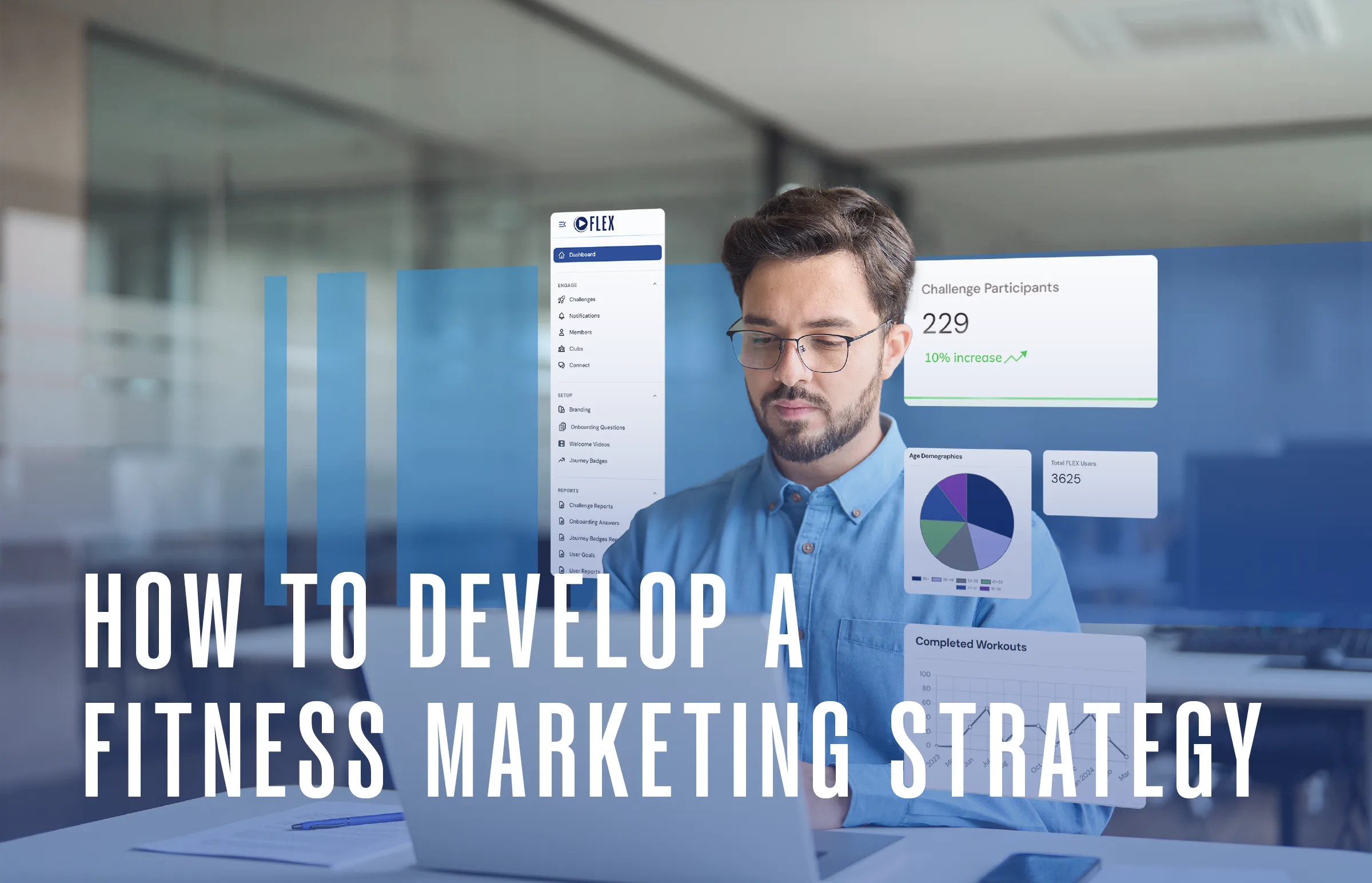Like in any industry, the competition in the fitness world is stiff. Yet, Statista says only 14% of surveyed Americans bought a gym membership in 2024. That means gyms and health clubs are competing to win over a lot of new members.

A strategic approach to marketing can help gyms and fitness centers determine what drives these customers and meet their demands more accurately. While marketing allows you to reach people and make them aware you exist, an effective strategy will ensure you position yourself better than your competitors and inspire customers to sign on for a membership.
Fitness marketing strategies serve as roadmaps to success in marketing, and this article will outline how to make them.
Why You Need a Fitness Marketing Strategy
Fitness marketing means promoting your brand and services to attract new and retain existing customers. A strategic approach to this promotion helps you boost:
Brand Awareness
Brand awareness refers to how familiar your target customer is with your brand. For example, people worldwide are very familiar with brands such as Nike, McDonald's, and Coca-Cola. We'd recognize the fonts, colors, and slogans of their branding anywhere. That's an example of strong brand awareness.
How do you create the same feeling of trust, loyalty, and familiarity for your customers? Strategic marketing will help you get your unique value proposition out there and show your customers who you are, what you do, and how you stand out. Showing a consistent brand identity, image, and voice across marketing channels will enhance customer confidence and trust and make you recognizable.
Client Engagement
The goal of every marketing campaign is to drive customer engagement. But people are unlikely to engage with generic ads and content.
Creating fitness marketing strategies means developing a more meaningful approach to marketing based on your target audience's interests and needs. This makes your offer more personalized and appealing, leading to better communication and relationships rather than mere conversions.
Membership Growth
An effective marketing strategy involves paying close attention to and addressing your customer's pain points and needs. This helps you identify weak spots in your current fitness marketing plans and improve them. Ultimately, the more adequately you address your potential clients' pain points, the more growth your gym will see.
Step 1: Identify Your Target Audience
How do you target a fitness market? Don't make the mistake of solidifying a brand identity before you know the groups you're targeting. Once you identify a target audience and create an ideal customer profile, you can start tailoring your fitness marketing strategies to those individuals — not the other way around.
Consider the following demographics:
- Fitness experts who seek specialized classes
- Health enthusiasts who like to keep abreast of new fitness trends, equipment, and courses
- Individuals with health problems who may need specialized assistance
- Professional or amateur athletes who intend to train for specific sports or activities
- Busy professionals who want convenient spaces and times to work out
Step 2: Develop a Strong Brand Identity
What are the cornerstones of your brand? Do you aim to attract younger, health-conscious consumers eager to learn about new virtual fitness platforms and state-of-the-art equipment? Or do you strive to build a family-friendly atmosphere that caters to parents of young children? Think about your mission, values, and how you speak and interact with your customers (your brand's voice) as you craft your content.
Your brand identity is how you want your potential customers to perceive your gym or fitness center, so it should reflect your unique value — and your gym marketing strategies should align with that value.
For example, gym marketing strategies that cater to young health enthusiasts may promote in-person and virtual classes aimed at people who work both from the office or home. On the other hand, the family-friendly gym may focus on perks such as free childcare for gym members.
Step 3: Build a Strong Online Presence
Building online fitness marketing strategies isn't as simple as setting up a business website for your gym or using email marketing tools, like a newsletter, to engage with customers. Today's customers want more.
Almost five million people worldwide use social media, meaning both your existing and potential gym members are most likely on it. This makes leveraging social media platforms essential to attract new and retain your current members.
A social media strategy will help you plan your marketing on social media platforms to achieve your goals. Ideally, it should align with your overall marketing goals and strategy, increasing brand awareness and overall customer engagement.
For example, your goal on Instagram may be to engage people through:
- Visually appealing gym photos that show your unique space and community
- Educational videos that position your gym as a professional fitness hub
- Enticing promotions that show your understanding of customers' needs
An essential part of a strong online presence is developing a solid content marketing strategy, whether on social media or elsewhere. This will help you create and share content, from blog posts to images and videos, that actually appeals to your customers — and promote your offerings.
For example, you may post a series of articles about cardio exercise that connects to what your gym (and brand) offers your audience.
Step 4: Implement Local SEO and Google My Business
When listing fitness marketing ideas, writing blogs, and designing your website, search engine optimization (SEO) should be at the forefront of your mind. SEO means optimizing online content to include specific words your target audience types in browsers when searching for the services you offer. This helps you appear higher in search engine result pages (SERPs), improving your chances of getting discovered by people.
If your gym has a physical location, your fitness marketing should ideally focus on local SEO, too. Including local search terms and important information, such as your physical location, will help you show up sooner in local searches.
For example, if your gym is in Los Angeles, you may want to include keywords such as "best gym in Los Angeles." Don't miss out on optimizing your Google Business Profile, too. It will allow Google to rank your business according to local searches and help you present yourself to locals. Potential members will be able to see your gym's critical information, such as contact and address, as well as photos and reviews, which play a big role in establishing a reputation in the community.

Step 5: Run Paid Advertising Campaigns
Paid advertising campaigns let you quickly reach more people by showing your ads in prominent places on the internet. You can use the following types of paid advertising:
- Pay-per-click advertising, which allows you to set up a "bid" amount on the campaign and pay per user click or impression
- Social media ads, which refer to paying to put your posts and videos in front of more people on Facebook, Twitter, Instagram
- Search engine ads, which put your content on the top of search engine result pages
Google Ads and Microsoft Advertising are two of the biggest and most popular online advertising platforms. They let you target specific demographics according to factors such as age and location and show your ads directly on specific websites local to your area.
Step 6: Leverage Influencer Marketing
Influencers typically have a large, built-in following on social media. Enlisting recognizable faces to spread the word about your fitness offerings can be a great way to expand your reach and establish trust. \
You can tap into the power of fitness influencers in several ways. You can invite a guest teacher if you have the budget to host in-person workout classes. Or, you can go the easier (and less expensive) route and include influencers' classes in your virtual fitness rotation.
Many influencers and celebrities in the fitness world host their own streaming workout channels or classes. You might exercise with Jillian Michaels' tailored programming, or you can work out with classes by well-known guest trainers on the PopSugar platform, such as Dianne Bondy, Natalie White, and Cody Rigsby.
Step 7: Measure and Adjust
A successful marketing strategy for a fitness center is not a set-it-and-forget-it thing. It's important to measure your performance over time to determine what works and what doesn't so you can adjust.
Review the Data
How can you know whether your campaigns and SEO strategies are performing well? Check on your metrics regularly. Consider compiling the data at the end of each month or quarter. Some key performance indicators (KPIs) to focus on are your search engine rankings, click-through rates, and conversion rates. Your conversion rate, specifically, will let you know how many people your marketing strategies have converted to real-life, paying customers at your gym.
Build On Your Foundation
Lean into what's working, even if it's not what you expected. For example, virtual pilates classes may be more popular than in-person classes at your studio. Make decisions about how to allocate your budget accordingly.
Be Ready to Pivot
If your strategy isn't working, be ready to make changes. For instance, if data tells you that your membership sign-ups suffered a steep drop-off, try to delve into what drew people away from your gym and fix the error for future campaigns.
Market a Unique Fitness Offering With Fitness On Demand
At the core of successful fitness marketing strategies lies a strong value proposition you can show the world. Make your offering more compelling by meeting customers where they are and personalizing your services.
Fitness On Demand blends physical and digital fitness experiences to help gyms provide customers with 24/7 on-demand workouts and content. Our platform allows you to save money by consolidating multiple subscriptions in different formats — such as virtual biking videos, yoga, meditation, pilates classes, and even cable — into one convenient platform.
With 1,500+ premium classes from renowned fitness brands, tailored programming, and a mobile app to simplify access to content, communications and scheduling, Fitness On Demand changes the entire fitness experience. Schedule your demo to learn more about how Fitness On Demand can enhance the success of fitness industry marketing strategies.

Author
Nick Gustafson
As a marketer and musician, Nick brings creativity, energy and excitement to everything he does. He's a big proponent of using data to identify new opportunities or improve existing processes, which has helped him create and execute key strategies that drive brand awareness, increase lead volume, and improve revenue for multiple companies.

